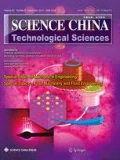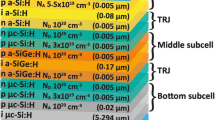Abstract
Because crystalline silicon thin film (CSiTF) solar cells possess the advantages of crystalline silicon solar cells such as high efficiency and stable performance and those of thin film solar cells such as low cost and so on, it is regarded as the next generation solar cell technology, which is most likely to replace the existing crystalline silicon solar cell technology. In this paper, we performed device simulation on the epitaxial CSiTF solar cell by using PC1D software. In order to make simulation results closer to the actual situation, we adopted a more realistic device structure and parameters. On this basis, we comprehensively and systematically investigated the effect of physical parameters of back surface field (BSF) layer, base and emitter, electrical quality of crystalline silicon active layer, situation of surface passivation, internal recombination and p-n junction leakage on the optoelectronic performance of the epitaxial CSiTF solar cell. Among various factors affecting the efficiency of the epitaxial CSiTF solar cell, we identified the three largest efficiency-affecting parameters. They are the base minority carrier diffusion length, the diode dark saturation current and the front surface recombination velocity in order. Through simulations, we found that the base is not the thicker the better, and the base minority carrier diffusion length must be taken into account when determining the optimal base thickness. When the base minority carrier diffusion length is smaller, the optimal base thickness should be less than or equal to the base minority carrier diffusion length; when the base minority carrier diffusion length is larger, the base minority carrier diffusion length should be at least twice the optimal base thickness. In addition, this paper not only illustrates the simulation results but also explains their changes from the aspect of physical mechanisms. Because epitaxial CSiTF solar cells possess a device structure that is similar to crystalline silicon solar cells, the conclusions drawn in this paper are also applied to crystalline silicon solar cells to a certain extent, particularly to thin silicon solar cells which are the hottest research topic at present.
Similar content being viewed by others
References
Ulzhöfer C, Altermatt P P, Harder N P, et al. Loss analysis of emitter-wrap-through silicon solar cells by means of experiment and three-dimensional device modeling. J Appl Phys, 2010, 107: 104509
Rahmouni M, Datta A, Chatterjee P, et al. Carrier transport and sensitivity issues in heterojunction with intrinsic thin layer solar cells on N-type crystalline silicon: A computer simulation study. J Appl Phys, 2010, 107: 054521
Datta A, Damon-Lacoste J, Roca i Cabarrocas P, et al. Defect states on the surfaces of a P-type crystalline silicon wafer and how they control the performance of a double heterojunction solar cell. Sol Energ Mat Sol C, 2008, 92: 1500–1507
Farrokh-Baroughi M, Sivoththaman S. Modelling of grain boundary effects in nanocrystalline/multicrystalline silicon heterojunction solar cells. Semicond Sci Tech, 2006, 21: 979–986
Harder N P, Mertens V, Brendel R. Numerical simulations of buried emitter back-junction solar cells. Prog Photovoltaics, 2009, 17: 253–263
Mader C, Müller J, Gatz S, et al. Rear-side point-contacts by inline thermal evaporation of aluminum. In: IEEE Electron Devices Society Staff, eds. The Conference Record of the 35th IEEE Photovoltaic Specialists Conference. Hawaii: Institute of Electrical and Electronics Engineers (IEEE), 2010. 1446–1449
Hilali M M, Nakayashiki K, Ebong A, et al. High-efficiency (19%) screen-printed textured cells on low-resistivity float-zone silicon with high sheet-resistance emitters. Prog Photovoltaics, 2006, 14: 135–144
Kang M H, Hong J, Cooper I, et al. Reduction in light induced degradation (LID) in B-doped Cz-Si solar cells with SiCxNy antireflection (AR) coating. J Electrochem Soc, 2011, 158: H724–H726
Clugston D A, Basore P A. PC1D version 5: 32-bit solar cell modeling on personal computers. In: IEEE Electron Devices Society, eds. The Conference Record of the 26th IEEE Photovoltaic Specialists Conference. Anaheim: Institute of Electrical and Electronics Engineers (IEEE), 1997. 207–210
Rover D T, Basore P A, Thorson G M. Solar cell modeling on personal computers. In: IEEE Electron Devices Society Staff, eds. The Conference Record of the 18th IEEE Photovoltaic Specialists Conference. Las Vegas: Institute of Electrical and Electronics Engineers (IEEE), 1985. 703–709
Basore P A, Rover D T, Smith A W. PC-1D version 2: Enhanced numerical solar cell modeling. In: IEEE Electron Devices Society Staff, eds. The Conference Record of the 20th IEEE Photovoltaic Specialists Conference. Las Vegas: Institute of Electrical and Electronics Engineers (IEEE), 1988. 389–396
Basore P A. PC-1D version 3: Improved speed and convergence. In: IEEE Electron Devices Society Staff, eds. The Conference Record of the 22nd IEEE Photovoltaic Specialists Conference. New York: Institute of Electrical and Electronics Engineers (IEEE), 1991. 299–302
Basore P A, Clugston D A. PC1D version 4 for Windows: From analysis to design. In: IEEE Electron Devices Society, eds. The Conference Record of the 25th IEEE Photovoltaic Specialists Conference. Washington: Institute of Electrical and Electronics Engineers (IEEE), 1996. 377–381
Reber S, Hurrle A, Eyer A, et al. Crystalline silicon thin-film solar cells—recent results at Fraunhofer ISE. Sol Energy, 2004, 77: 865–875
Ai B, Shen H, Liang Z C, et al. Study on epitaxial silicon thin film solar cells on low cost silicon ribbon substrates. J Cryst Growth, 2005, 276: 83–91
Zhao Y W, Geng X H, Wang W J, et al. R & D activities of silicon-based thin-film solar cells in China. Phys Status Solidi A, 2006, 203: 714–720
Gordon I, Carnel L, Van Gestel D, et al. 8% efficient thin-film polycrystalline-silicon solar cells based on aluminum-induced crystallization and thermal CVD. Prog Photovoltaics, 2007, 15: 575–586
Wang J H, Lien S Y, Chen C F, et al. Large-grain polycrystalline silicon solar cell on epitaxial thickening of AIC seed layer by Hot Wire CVD. IEEE Electr Device L, 2010, 31: 38–40
Perraki V. Modelling of recombination velocity and doping influence in epitaxial silicon solar cells. Sol Energ Mat Sol C, 2010, 94: 1597–1603
Faller F R. Epitaxial Silicon Thin-film Solar Cells. Dissertation of Doctoral Degree. Freiburg: Albert Ludwigs University, 1998. 6–30
Ai B, Shen H, Ban Q, et al. QE and Suns-Voc study on the epitaxial CSiTF solar cells. Sci China Ser E-Tech Sci, 2005, 48: 41–52
Li X D. Study on Crystalline Silicon Thin Film Solar Cells on Low Cost Substrates. Dissertation of Doctoral Degree. Beijing: Beijing Normal University, 2003. 55–59
Ai B. Epitaxial Silicon Thin Film Solar Cells on SSP Substrates and Optimum Sizing of PV and Hybrid Systems. Dissertation of Doctoral Degree. Beijing: Graduate School of the Chinese Academy of Sciences, 2003. 153–190
Ai B, Shen H, Liang Z C, et al. Electrical properties of B-doped polycrystalline silicon thin films prepared by rapid thermal chemical vapour deposition. Thin Solid Films, 2006, 497: 157–162
Green M A. Silicon Solar Cells: Advanced Principles & Practice. Sydney: University of New South Wales, 1995. 333–336
Green M A. Solar Cells: Operating Principles, Technology and System Applications. Sydney: University of New South Wales, 1998. 76–96
Author information
Authors and Affiliations
Corresponding author
Rights and permissions
About this article
Cite this article
Ai, B., Zhang, Y., Deng, Y. et al. Study on device simulation and performance optimization of the epitaxial crystalline silicon thin film solar cell. Sci. China Technol. Sci. 55, 3187–3199 (2012). https://doi.org/10.1007/s11431-012-5004-5
Received:
Accepted:
Published:
Issue Date:
DOI: https://doi.org/10.1007/s11431-012-5004-5




